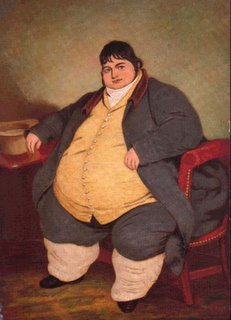Galen, a first century Roman physician, reported meeting Nichomachus of Smyrna – a man who was so heavy that he could not move nor be moved from his bed. Other ancient texts cite the case of an unnamed Roman senator who was only able to walk when two slaves carried his belly for him, and another yarn of an Egyptian pharaoh whose belly was broader than the ‘span of a man’s outstretched arms’.
The Dutch physician Hermann Boerhaave once observed a man who took his meals at a table that ‘had been cut away in a semicircle to accommodate his circumference’. Furthermore the man ‘not having slaves to help him, used a sling worn around his shoulders to carry his belly’.
In 1889, an attempt was made to put a young French woman in Plaisance on exhibit. It was said that ‘eight men could not move her from her room’. As it turned out, she couldn’t fit through the door and the idea of exhibition was abandoned.
AND FURTHERMORE :
 On March 13, 1770 a man was born in Leicester in England whose name would enter into the English language to be synonymous with colossal. Daniel Lambert was a fairly rotund man in his youth; healthy and stout. He was of average height and born unto average parents, he had two sisters and a younger brother – all of whom were average as well. He was an active man and unusually strong. At the age of 20, as his mass started to grow – he consciously remained active and watched his diet. However, in the 1790’s Daniel took over his father’s position as keeper of Leicester prison – and took up a stationary lifestyle. In 1793, he weighed 448 pounds – in a time when the greatest weight ever medically recorded in England was around 616 pounds. Despite his weight, Lambert was still quite strong and showed little sign of fatigue as he gave swimming and hunting lessons. However, his weight continued and in 1801, at 560 pounds, he could no longer hunt, his horse simply could not bear his weight. In 1805, his prison closed down and, after a brief time as a recluse and ballooning to a legitimate 700 pounds, he took to exhibiting himself for profit.
On March 13, 1770 a man was born in Leicester in England whose name would enter into the English language to be synonymous with colossal. Daniel Lambert was a fairly rotund man in his youth; healthy and stout. He was of average height and born unto average parents, he had two sisters and a younger brother – all of whom were average as well. He was an active man and unusually strong. At the age of 20, as his mass started to grow – he consciously remained active and watched his diet. However, in the 1790’s Daniel took over his father’s position as keeper of Leicester prison – and took up a stationary lifestyle. In 1793, he weighed 448 pounds – in a time when the greatest weight ever medically recorded in England was around 616 pounds. Despite his weight, Lambert was still quite strong and showed little sign of fatigue as he gave swimming and hunting lessons. However, his weight continued and in 1801, at 560 pounds, he could no longer hunt, his horse simply could not bear his weight. In 1805, his prison closed down and, after a brief time as a recluse and ballooning to a legitimate 700 pounds, he took to exhibiting himself for profit.
Lambert was an exceptionally bright man, possessed of a razor wit and while most came to see him out of interest and respect – he did have to deal with the occasional heckler. His retorts were legendary. On one particular occasion an obnoxious fellow was persistent and adamant in knowing the cost of Lamberts waistcoat – a rather rude question in that era – when Lambert politely refused to answer the question the heckler remarked that since he had paid a shilling (the cost of admission) toward the cost of the coat, he had a right to demand any information about it. ‘Sir,’ replied Lambert, ‘I can assure you that if I knew what part of my coat your shilling would pay for, I would cut out that piece.’
During his lifetime, Lambert was the subject of many writings including the Medical and Physical Journal, countless flyers, newspapers and caricatures and even appeared in the Memoirs of Charles Mathews (a popular actor of the era). He rubbed elbows with the affluent in influential of the time. He met King George III, visiting officers of Napoleon, royalty, ambassadors and even an elderly Josef Boruwlaski – certainly a stunning meeting as the biggest man of that time met the smallest.
When Lambert died in 1808, still in relative good health except for nagging knees, he weighed in at 739 pounds. His waist measured 9 feet and 4 inches. He was immensely popular due to his wit and easy going nature. People were in awe of not only his size, but of his spirit as well. Many regarded him as a true jovial, gentle giant – a reputation that would carry to the big jolly sideshow men and women who would follow in his ample shoes for decades.
Following his death, Lambert was featured in his own biography: The Life of that Wonderful and Extraordinary Heavy Man, the late Daniel Lambert. He was also featured in Granger’s Wonderful Museum and Magazine Extraordinary, Smeeton’s Biographia Curiosa. He is referred to in great novels like Barry Lyndon, Vanity Fair and even Charles Dickenson’s Nicholas Nickleby. Lambert’s popularity even spread to America following his death as P.T. Barnum displayed a wax version of Lambert, dressed in a suit of clothing purchased from the Lambert estate. During Barnum’s museum fire of 1865 – the wax representation was fittingly too heavy to rescue.
It was also Dickens who, in his magazine Household Words forever cemented the name Daniel Lambert with hugeness. Even today, there are numerous Pubs, Taverns and Inns named after Lambert – with the keepers hoping the clientele will associate the name with ample portions of food and drink. Oddly enough, Lambert likely suffered from a pituitary obesity – he reputedly never ate a large meal or drank beer.
The Mountainous Human Marvel is all but gone now, with only one Fat Man, Howard Huge, still traveling. The obese are no longer looked upon in wonder, interest and awe – rather with disgust and insensitivity. In fact just a few short years ago, at St. Martin’s churchyard in Stamford, someone spray-painted the word FATTY on Lambert’s tombstone.
Adapted from the book The Two Headed Boy by Jan Bondeson .
 “What the hell, I’m 75,” said Bristow resident Mona Shaw about heading into the Comcast office in Manassas with a hammer and using it on a telephone and computer keyboard, after trying for days to have her phone service connected.
“What the hell, I’m 75,” said Bristow resident Mona Shaw about heading into the Comcast office in Manassas with a hammer and using it on a telephone and computer keyboard, after trying for days to have her phone service connected.
